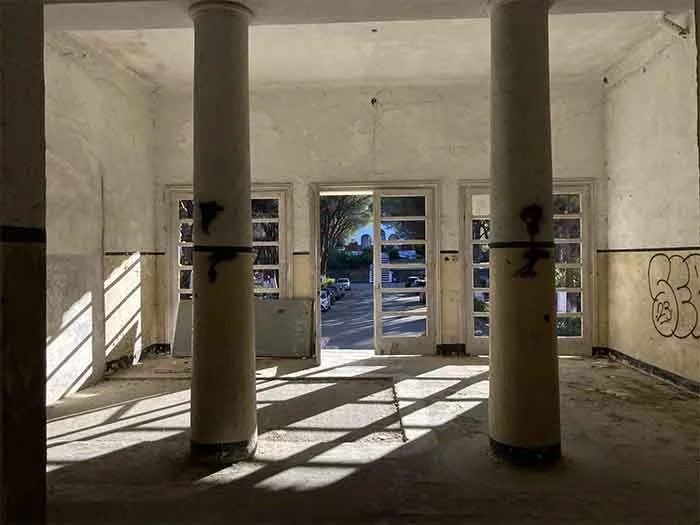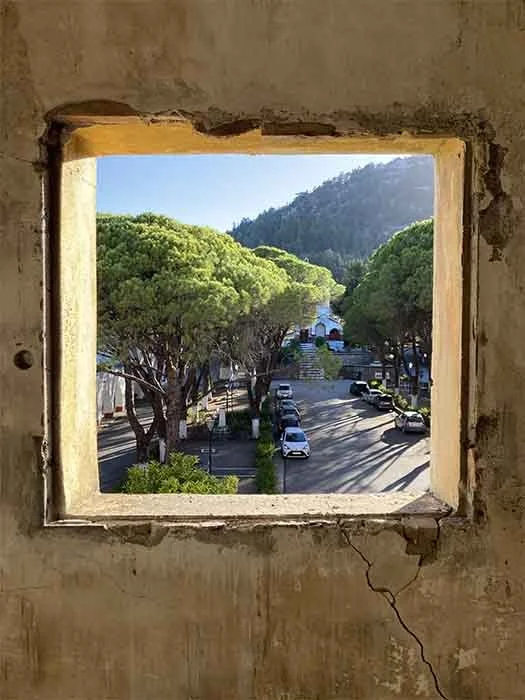Frozen in time: exploring Eleousa, Rhodes’ abandoned Italian village
Rhodes is an island steeped in history. It boasts many ancient ruins, from the iconic Lindos Acropolis to the historic Olympic Stadium in Rhodes Town. However, in my opinion, the ruins of Eleousa, an abandoned Italian village from the 1930s, are among the most fascinating. While relatively modern, Eleousa’s unique history and off-the-beaten-path location make it a must-see for history lovers and urban explorers alike.
Why Eleousa is a must-visit for history buffs in Rhodes
Eleousa is nestled in the mountainous interior of Rhodes, with a history that is both unique and surprising, reflecting the island’s complex past.
Unlike more touristy spots, Eleousa's ruins are open for exploration with very little in the way of health and safety signage… no ‘DANGER’ signs to be found here. I love this unfiltered access, as it adds to the sense of adventure. However, be warned: I almost took out the undercarriage of our rental car on some narrow, winding logging roads. I’d recommend plotting your route ahead of time, as Google Maps sent us on a wild goose chase. That said, finding Eleousa was one of the highlights of our trip!
When I visited, it was incredibly quiet, with just one other couple present, making it an atmospheric, almost eerie experience.
Historical significance of Eleousa: from Italian village to abandoned ruins
Originally known as Campochiaro, Eleousa was constructed during the Italian occupation of Rhodes in the early 20th century. From 1912 to 1943, the Italians controlled Rhodes and embarked on a massive modernization project to ‘Italianize’ the island. In the 1930s, Eleousa was built as a model village for workers engaged in forestry and agricultural projects aimed at revitalizing the island's rural economy.
The village's architecture, a mix of Italian and Art Deco styles, still stands today, giving Eleousa a distinct charm.
It was primarily inhabited by workers involved in reforestation efforts to protect the lush forests around Mount Profitis Ilias. After World War II, when the Italians left, Eleousa fell under British control and, in 1947, became part of Greece. The village's name was eventually changed from Campochiaro to Eleousa.
Eleousa also has a darker chapter in its history: a sanatorium was established here to treat tuberculosis patients, operating until medical advances rendered the facility unnecessary.
Modern-day Eleousa: a quiet abandoned village surrounded by nature
Today, Eleousa is a quiet, abandoned village surrounded by lush forests and natural beauty. Its Italian-era architecture serves as a fascinating reminder of its past, making it a great spot for history enthusiasts. Nearby attractions, like the eerie sanatorium and the Agios Nikolaos Fountoukli Church, add to the village's historical allure.
Eleousa's unique character sets it apart from other villages on Rhodes. Whether you're fascinated by Italian-era architecture or the remnants of the village’s post-war role, Eleousa offers a hauntingly beautiful snapshot of Rhodes’ complex history.
What to see in Eleousa village (Campochiarro)
The old sanatorium
Once a tuberculosis hospital, this was one of the first in Greece and treated patients until the early 1970s. Built in the late 1940s and originally named the Queen Frederica Sanatorium, it could house up to 80 patients and employed dozens of staff. Its remote location in the forested hills was chosen to isolate the sick and prevent the spread of disease. Today, the building stands in ruins, its crumbling corridors and broken tiles still hinting at its once-critical role in public health.The fountain and water reservoir
Just beyond the main square sits a circular stone pond, part of the original hydro-engineering system designed by the Italians. This tranquil feature once helped irrigate the surrounding farmland and now serves as a peaceful landmark. It also houses the Gizani fish, a small freshwater species found only in Rhodes.St Nikolaos Fountoukli church
This small 15th-century Byzantine chapel lies a short drive from Eleousa, nestled in a pine-shaded clearing. Known for its remarkably well-preserved frescoes, it’s one of the best examples of post-Byzantine religious art on the island. The church offers a quiet, reflective stop and a striking contrast to the abandoned ruins nearby.Elafos and Elafina hotels
Situated higher up Mount Profitis Ilias, these two hotels were built during the Italian occupation and styled to mimic Alpine mountain lodges. Elafos opened in 1929 to accommodate Italian officials and was later used by German forces as a military hospital during World War II. Elafina was added in 1932 but never reached the same level of maintenance and has since fallen into deep decay. While Elafos has been partially restored and occasionally hosts events, Elafina remains abandoned, offering a powerful and eerie glimpse into the past.
For more in-depth background and photos, this local blog on Eleousa offers fascinating insights into its Italian roots and current state of decay.
Top things to do near Eleousa: must-see attractions and hidden gems
Finding Eleousa is straightforward, and the village makes for an enjoyable half-day trip, particularly if you're exploring the inland side of Rhodes. Below are some nearby attractions worth adding to your itinerary.
If you're planning a visit to Eleousa, be sure to check out these nearby attractions to make the most of your trip:
Butterfly Valley (Petaloudes)
Distance from Eleousa: ~10 km
A picturesque valley filled with walking trails and wooden bridges. In summer, thousands of butterflies cling to the tree trunks, making it a magical experience (best seen from June to August). Even outside of butterfly season, the peaceful forest walk is worth the visit.Agios Nikolaos Fountoukli Church
Distance from Eleousa: Very close
A serene, 15th-century Byzantine chapel hidden in a pine forest, with beautifully preserved frescoes. It’s the perfect stop for those seeking spiritual calm and historical depth.Profitis Ilias Mountain and Italian heritage sites
Distance from Eleousa: Just past
Drive or hike to Profitis Ilias for panoramic views of Rhodes and to see abandoned Italian-era hotels, such as the eerie "Elafos" and "Elafina." The high altitude brings a refreshing chill, making it a cool escape from the island's warmer temperatures.Apollona Village
Distance from Eleousa: ~15–20 minutes
A charming mountain village known for its traditional architecture and local products like honey and olive oil. Stop by for lunch at one of the excellent local tavernas.Seven Springs (Epta Piges)
Distance from Eleousa: On the way from Rhodes Town
A lush, tranquil spot with a small lake fed by natural springs. The unique tunnel walk under the hillside is a must-do for nature lovers.Bee Museum (Pastida)
Distance from Eleousa: On the route from Rhodes Town
Learn about Rhodes' beekeeping tradition and see live beehives. The museum offers a fascinating experience for families or anyone interested in offbeat attractions. Plan your visit to the Bee Museum of Rhodes for an educational stop with local flavor.
Bonus: Psinthos Village
A peaceful village with a traditional square, local tavernas, and an authentic rural atmosphere. It’s ideal for a quiet coffee or lunch break.
How to get to Eleousa: driving directions, public transit, and taxi options
By car (best option):
Eleousa is about 30 km southwest of Rhodes Town, nestled in the foothills of Mount Profitis Ilias. If you're driving, simply enter ‘Eleousa village’ into Google Maps. The scenic 40-minute drive will take you through charming villages and lush forests, perfect for photo opportunities along the way.
By bus:
There are public buses that head toward Apollona or Embonas, with some routes passing near Eleousa. However, the bus schedule can be infrequent, especially during the off-season. Check the KTEL Rhodes bus schedule in advance if you’re relying on public transportation.
By taxi:
A taxi from Rhodes Town or nearby resorts is another option. While it's comfortable, it’s a more expensive choice. If you opt for a taxi, ask the driver to wait, as it may be difficult to find a return taxi in the village.
Why Eleousa belongs on your Rhodes itinerary
Eleousa isn’t just another stop on the map—it’s a rare glimpse into a bygone era, where history, architecture, and nature collide in an unexpectedly haunting way. Whether you’re a history enthusiast, urban explorer, or simply curious about the lesser-known corners of Rhodes, this abandoned Italian village offers a peaceful, eerie, and totally unforgettable experience.
If you've had any exciting urban exploration experiences, I’d love to hear about them in the comments below. And for more hidden gems in Rhodes, be sure to check out my full guide here!










